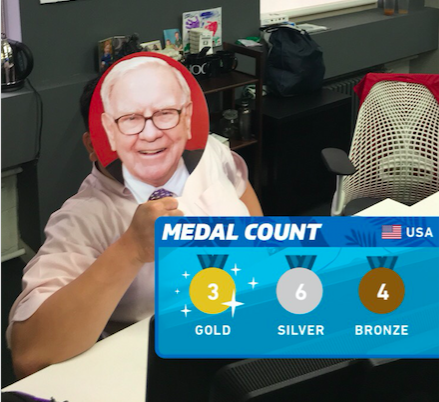How Twitter, Facebook, and Snapchat are battling it out at the Olympics
Just before the Rio Olympics began, Twitter announced a suite of new features for engaging with and discussing the Summer Games. The features, the company said, will help fans, “share their passion” and “feel the Olympic spirit.” But Twitter’s biggest competitors—Facebook, Facebook-owned Instagram, and Snapchat—all want to do the same thing, and all rolled out new Olympics features to do so.
It is a reminder that the battle between these four platforms over live sports content is heating up. The Olympics provides them with a nice setting in which to wage this battle. But it is merely the latest (large) event for them to rally around.
Most of the new features are closer to light bells-and-whistles than monumental business shifts.
Twitter added a dedicated Olympics section to its Moments section that summarizes news events in multi-tweet slideshows, it added more than 200 official Olympics hashtags that automatically load an emoji, and it will project tweets live onto the Arcos de Lapa aqueduct in Rio.
#waterpolo ???????? we have our own little Twitter emoji now? Yessssss! @USAWP #Olympics2016 #waterpolo #waterpolo #waterpolo ????????????????????????
— Sami Hill (@samihillusa) August 8, 2016
Facebook announced whimsical flag filters that can go over your profile picture, or over your face when you use the Facebook-owned app MSQRD. Facebook also has exclusive Olympics content, like highlights, but it cannot live-stream any Olympics events as they happen.
Snapchat signed a unique partnership with NBC to show Olympics content on Snapchat’s curated Stories. (The deal was also a smart move by NBC Universal and parent company Comcast that signaled it recognizes, at last, the importance of mobile social platforms.) Snapchat also offers users a filter that shows the up-to-the-minute total medal count.

These are all fun ways to follow the Olympics, but nothing that necessarily signals a permanent change to the platforms.
The exception is Instagram, which used the occasion of the Olympics to announce a big, bold, controversial new step into disappearing Instagram Stories that work exactly like Snapchat Stories. While the Stories are a major step for Instagram that will stick around far beyond the Olympics, Instagram framed the launch around sports. It touted that Serena Williams would be the first pro athlete to use Instagram Stories, and would use it to share her Olympic journey.
All of these platforms want to be the go-to place for in-the-moment sports content, the first thought that sports fans have when they’re watching a game and want to say something about it or see what others are saying.
Twitter has long been the reigning king of live sports conversation, and it looks best positioned to remain the king. For starters, it owns Periscope and Vine (a fact people often forget, since it very much brands them separately), mobile apps for live-streaming video and for more polished viral videos, respectively. Apart from fans broadcasting live sports events on Periscope (often against the wishes of the event’s organizers), Twitter hadn’t shown any serious effort to use the apps to aid its sports primacy efforts. Now, for the Olympics, Periscope and Vine are both getting a featured channel for Olympics videos.
And separately from the Olympics, this year Twitter scored deals with all four major American sports leagues to live-stream some of their games. The NFL came first, announcing in April it had sold Twitter a package of 10 Thursday Night Football games that it can stream live on desktop and mobile devices at the same time as the games air on television. In July, Twitter live-streamed Wimbledon tennis. It also announced new deals with the NBA, MLB, and NHL to live-stream games. Last season, Yahoo (parent company of Yahoo Finance) became the first digital platform to live-stream an NFL game when it offered a Buffalo Bills-Jacksonville Jaguars game on Oct. 25 for free; a total of 15.2 million people tuned in at some point.
The streaming deals could help boost Twitter’s stock after disappointing second-quarter earnings last month, since the company will be able to sell more ads on its platform to run during sports live streams. Facebook launched a “Sports Stadium” live conversation feature this year, but it has largely gone unnoticed; it has also dived into live video, but it has nothing close to live sports streaming, and there is big excitement around what Twitter will do with the opportunity. Twitter stock is down 21% in 2016, but up 3% in the last month.
On the other hand, Facebook and Instagram benefit from a much larger built-in user base than Twitter or Snapchat: 1.71 billion monthly active Facebook users and 500 million monthly active Instagram users. Compare that to the 315 million monthly active users of Twitter and the 100 million daily active users of Snapchat.
Which social network will you use the most during the Olympics?
— Daniel Roberts (@readDanwrite) August 3, 2016
Can new Olympics goodies help Facebook, Instagram, or Snapchat unseat Twitter? That’s unlikely. But if any of the new features from these three platforms are truly big hits, it could be an important incremental gain in an ongoing contest that is only getting hotter.
—
Daniel Roberts is a writer at Yahoo Finance, covering sports business and technology. Follow him on Twitter at @readDanwrite. Sportsbook is our recurring sports business video series.
Read more Olympics coverage from Yahoo Finance:
The biggest business story at the Rio Olympics is this marketing rule change
‘There has never been a great Olympics’ says former top editor of Sports Illustrated